10 Vintage Chocolate Boxes Worth More Than the Candy Ever Was
It may surprise you, but vintage chocolate boxes are often worth more than the candy that came inside them. Many of these boxes are now cherished for their artistic designs and the memories they evoke. They capture a moment in time, representing an era when packaging was as important as the product itself. Over time, these boxes have become rare finds, and their value has only increased.
This post may contain affiliate links, which helps keep this content free. Please read our disclosure for more info.
Whitman’s Sampler Metal Tin

Back in the early 1930s Whitman’s produced a metal-tin version of their Sampler box which featured the signature stitched sampler motif on the lid. The standout feature is the original pressed tin box with the art of a home-style sampler design rather than just cardboard, making it a desirable piece of packaging history. Because metal tins survive better and fewer of them remain in good condition, these boxes fetch higher prices than the candy they once held. Today a clean tin might sell for around US$200 to US$400 depending on condition and completeness. Collectors value those with original paint finish and no major rust or damage.
Many of these tins were reused after the candy was eaten, which means vintage examples often show wear or repurposing. Items that still have their original lid-art, original hinges, and correct era labelling are especially sought. The connection to an established brand and a decorative tin rather than plain cardboard gives these boxes staying power. When you are considering one check for authenticity of the lid art, whether the box has been polished or repainted (which lowers value), and if it still closes properly. For someone interested in vintage confectionery packaging this kind of piece holds more collectible appeal than the sweets that were inside.
Hoadley’s Pagoda Chocolates Box
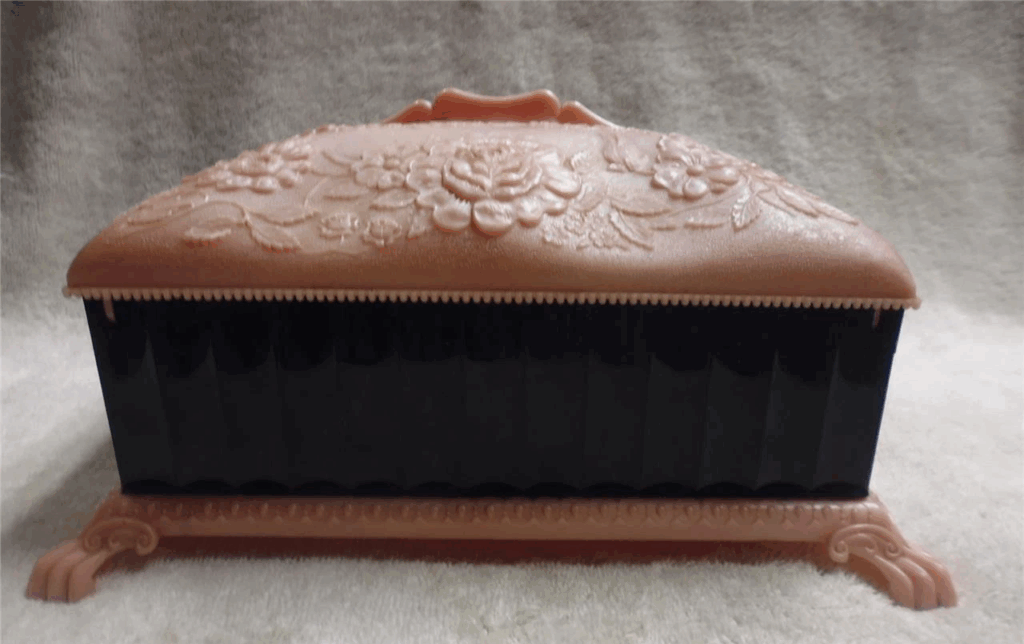
Hoadley’s produced a plastic-covered embossed design box for their Violet Chocolate Assortment in the 1950s, marketed under the theme Pagoda Chocolates. The feature that sets this box apart is its decorative hard-plastic lid with embossed motif-a rare feature in confectionery packaging of that era. Since hard-plastic boxes of that period were less common and many have been lost or broken, the surviving units command collector interest and value above the candy content. Today one might bring around US$250 to US$450 in a good condition example. The geographic origin (Australia) adds a layer of rarity for global collectors.
Because the brand ceased independent production and packaging styles changed, these types of boxes are no longer made, which increases their appeal. When evaluating one look for intact lid embossing, clear original label printing, minimal cracking or crazing in the plastic, and completeness of the box. Damage such as melted residual chocolate or heavy discoloration will reduce value. For someone assembling a collection of vintage chocolate containers this box stands out as both decorative and rarely found.
Rowntree’s Black Magic Tin
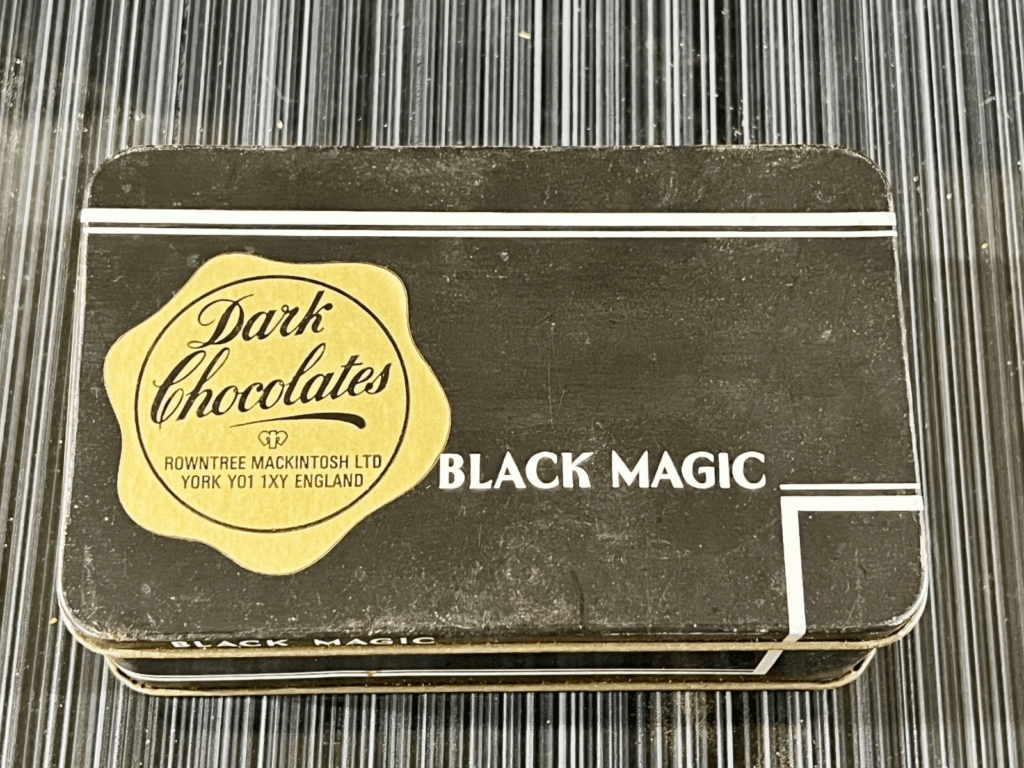
The Black Magic boxed chocolates were introduced in the UK by Rowntree’s in 1933 and some early tins from the 1930s reflect throw-back presentation styles. What makes the tin interesting is the original advertising theme and graphic design of the era, including lithographed imagery that remains collectible. Because the tin packaging was premium and few survive with perfect graphics, these items usually carry a higher value than the chocolates themselves did. Market value for a good intact tin from that period can range from US$150 to US$300. The tin appeals to those who collect chocolate memorabilia or vintage tins.
Apart from the brand connection the box design marks a shift to decorative packaging in the mid-20th century. If a tin still has original finish, no major dents, and the lid aligns properly it stands out. Missing or replaced lids, heavy wear, or repainting will markedly reduce worth. Checking the waxed interior or original liner can increase confidence in originality. These boxes serve as both packaging history and decorative display piece, which helps explain why the box may be more sought after than the candy once was.
Schrafft’s Chocolates Velvet Heart Box
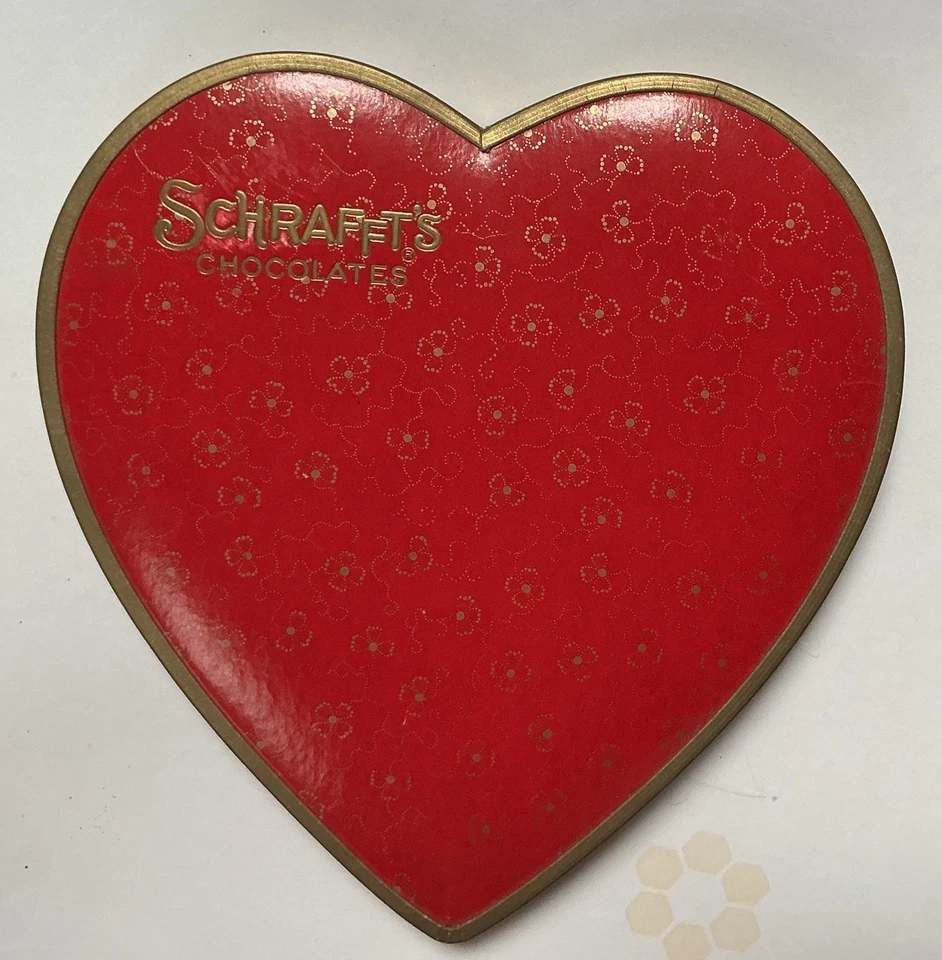
Schrafft’s produced heart-shaped Valentine’s boxes in the 1940s with velvet coverings and embossed designs – giving them a decorative appeal beyond the candy. The key feature here is the velvet heart box itself which was often reused after the chocolates were gone, making intact examples rarer than the original candy. As a result these boxes can command values around US$180 to US$350 depending on condition and rarity. Collectors prize the original fabric covering and bright colour retention in the heart-shaped container. The box offers a window into how gifting chocolate was tied to decorative presentation.
Because many of these boxes were repurposed as trinket boxes the original label or insert may be missing, reducing value. Condition of the velvet, intact embossing, minimal fading, and original interior liner all matter. If the hinged lid still functions and the box retains original shape it stands out. For someone interested in vintage Valentine’s ephemera or chocolate collectibles this box is a strong candidate. Its appeal comes from the packaging design rather than the confection inside.
Terry’s Chocolate Box
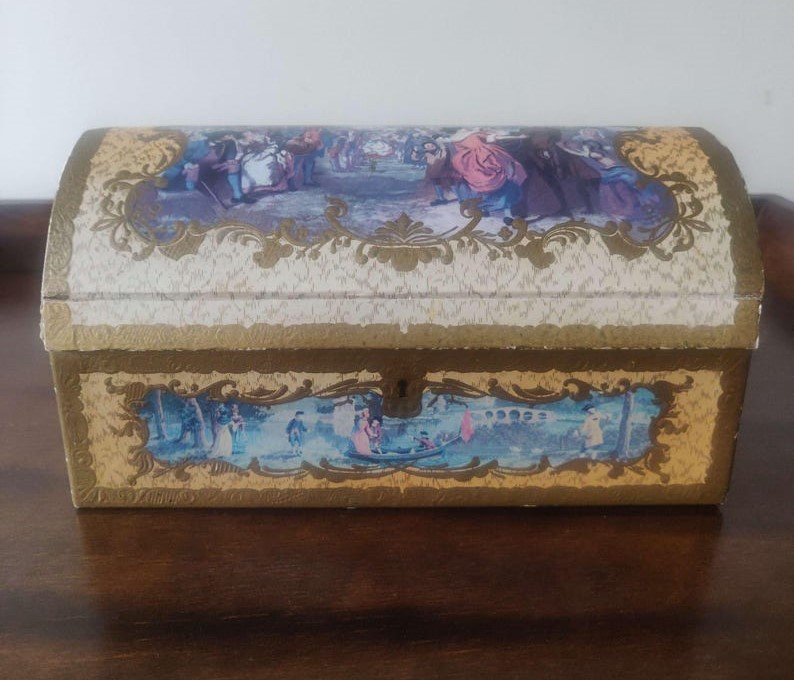
Terry’s produced a boxed chocolate product in the 1950s in a decorative cardboard box, often sold as a gift. What makes this box collectible is the survival of mid-century design and brand packaging which many brands no longer use. Given that many were discarded once the chocolates were eaten, those in good condition have become more valuable than the candy originally contained. Current market values for well-preserved models hover around US$120 to US$280. The box appeals to vintage British confectionery collectors and design lovers.
Important details when evaluating include original lid artwork, intact side panels, correct era printing (for example Made in England), and minimal staining from chocolate residue. If the box is unread, never opened or has original wrapper it may carry premium. Heavy wear or missing parts will reduce value. It serves as an example of how packaging has become part of vintage collectible culture rather than just a container.
Fannie Farmer Santa-Shaped Chocolate Box
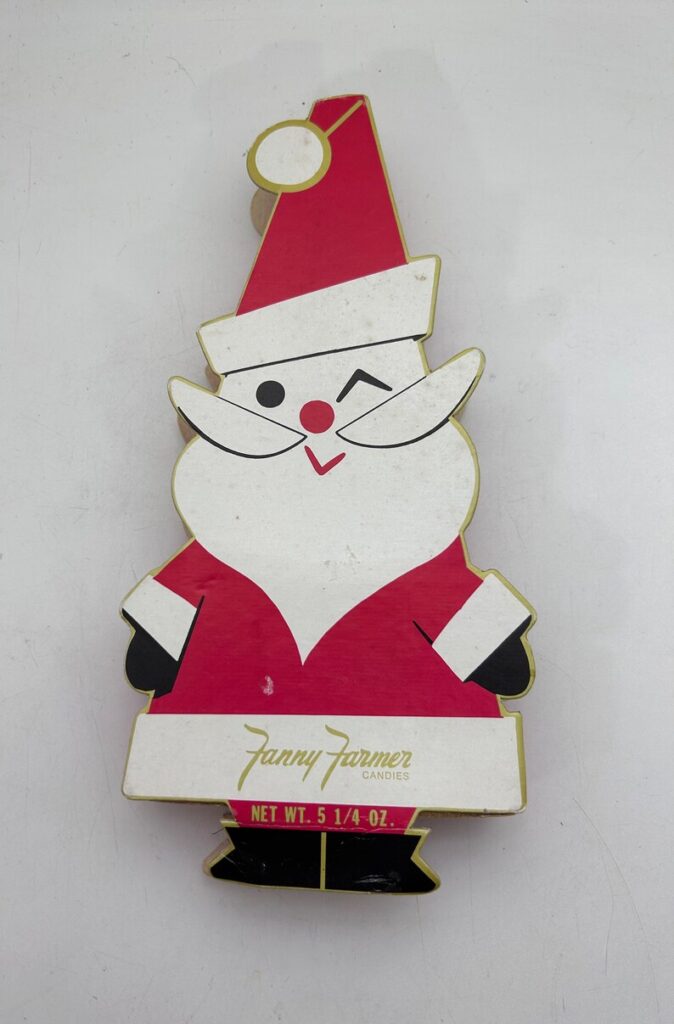
Fannie Farmer produced a Santa-shaped box for holiday chocolates in the 1940s that has since become a holiday collectible. The feature that elevates the box value is the shape-design and seasonal artwork which makes it attractive as décor as much as a container. Because most holiday chocolate boxes were discarded after use, intact and original Santa-shaped items have greater value than the sweets they once held. A strong example might fetch US$150 to US$300 in today’s market. The box appeals to collectors of holiday packaging and vintage candy memorabilia.
Condition matters a lot: original printing with minimal fading, intact shape without crushed corners, no missing tabs or tears. If the interior still contains its original liner or wrapper it may command higher value. Missing parts, water damage or heavy wear reduce the box’s appeal. For someone assembling a collection of holiday packaging this example shows how chocolate boxes have significance beyond their edible contents.
Moir’s Pot of Gold XXX Assortment Box

Moir’s chocolates in Canada issued a Pot of Gold XXX boxed assortment in the 1950s. The decorative box is more collectible than the candy that was inside. The decorative motif and Canadian origin give it a special place among North American chocolate packaging items. Because fewer of these Canadian boxes remain in good condition, they often carry value beyond the sweet originally sold. A clean box could command around US$90 to US$200 today. The box appeals to Canadian confectionery collectors and packaging historians.
When examining one check for original colour, intact lid and side flaps, absence of water damage or chocolate seepage, and original inserts if present. Missing inserts or heavy wear reduce value significantly. For someone exploring vintage packaging this is a lesser-known brand but interesting as a piece of Canadian confectionery design.
Walter Baker and Co. Premium Chocolate Wood Box

Walter Baker and Co produced premium chocolate and issued a wooden crate or box around the early 1900s which has since become a collector’s display piece. The feature of note is the wooden construction and the branded metal plate or embossing which make it far more durable and collectible than typical cardboard packaging. Because very few of these wood-branded boxes survive undamaged, they are more valuable now than the candy they once held. Market estimates for one in good display condition might reach US$300 to US$500. The wooden box appeals to collectors of early confectionery and industrial design.
As with any wooden vintage box check for intact branding, absence of wood rot or insect damage, original hardware (hinges or clasps) and clear brand inscription. Repaired or heavily modified boxes drop in value. For someone collecting industrial or confectionery memorabilia this piece bridges both worlds.
Artstyle Chocolate Co. Tin Box With Love to Mother

Artstyle produced a tin box in the 1920s embossed with the phrase With Love to Mother which has become a collectible item. The design feature that stands out is the early art-deco styling and sentiment, making it attractive as a vintage keepsake beyond its original use. Because packaging of that era was less durable and few have survived intact, these tins tend to find higher value than the candy inside ever did. Today a good example might sell for US$120 to US$250. The piece appeals to lovers of art décor and vintage packaging.
Important aspects include original embossing, working hinge or lid, minimal rust or scratching and clear original colour. If the tin still has its original interior liner or label that often increases value. Boxes with heavy damage, repainting or missing lids will be less desirable. For someone tracking early 20th-century chocolate packaging this model offers both charm and historical reference.
Lowney’s Vesta Chocolate Box

Lowney’s of Brockton, Massachusetts produced a Vesta chocolate box in the 1920s which is now sought after by collectors of vintage candy packaging. The distinguishing feature is the box’s early 20th-century artwork and branded design that reflect the era’s marketing style. Because very few of these boxes survive with their original artwork intact, they are often more valuable than the candy they once held. Presently one in good condition might sell for approximately US$120 to US$240. The box appeals to those who appreciate early advertising and confectionery history.
As part of appraisal check for strong artwork, crisp box edges, minimal wear to the printed graphics, and original interior liner or tray if present. Boxes that have been heavily cleaned or repainted will find less market interest. For someone exploring early packaging and confectionery memorabilia this piece offers both historical context and collectible appeal.
This article originally appeared on Avocadu.
